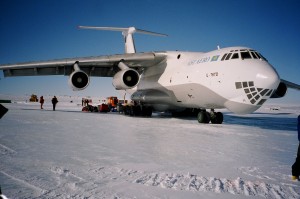
One hundred years after explorers first reached the South Pole, Antarctica’s appeal as one of the last pockets of wilderness left in the world hasn’t faded. Images of white expanses and frozen seas attract thousands of people each year to see what they think is a pristine, unaffected land.
But the resulting tourism explosion may be diminishing the very wilderness that visitors set out to experience.
Antarctica, apparently, just isn’t as far away as it used to be. The Southern Continent has become dramatically more accessible over the last several decades, Nick Clinch said in an interview before “Science and Exploration in Antarctica: Reflections on the Heroic Age and Beyond,” an event at Stanford University last month. Clinch led the 1966 expedition that made the first ascent of Mt. Vinson Massif, Antarctica’s highest mountain.
Back then, Clinch said, “the whole thing that made climbing Mt. Vinson different from a mountaineering point of view was just getting to the damn thing.” His expedition took 40 days and came with the support of the U.S. Navy and the National Science Foundation.
Today, mountaineers can fly in and make the ascent in just a week.
Clinch spoke on a panel of five scientists, explorers and historians at the event. The panel addressed both personal experiences in Antarctica and how the human experience there has changed since the height of the “heroic age,” when explorers Roald Amundsen and Robert Falcon Scott finished the race to the South Pole.
That sort of extreme trek would still be forbidding. But the real boom in Antarctic visits is on the Antarctic Peninsula, a finger of land that stretches north toward South America. That’s where 95 percent of tourists to the continent go, according to panelist Joan Boothe, who wrote The Storied Ice: Exploration, Discovery and Adventure in Antarctica’s Peninsula Region. According to the International Association of Antarctic Tour Operators, 18,734 individual tourists set foot on the Antarctic Peninsula in the 2010-2011 season, from late October to March—a number that likely would have been even higher in a better economy. (An additional 14,373 people visited the peninsula by cruise ships that never docked there.)
The rise in visitors not only takes away from the exclusivity that once surrounded Antarctica, it also poses environmental concerns. Scientists have found that non-native organisms, including microbes, algae and fungi, are being carried in by human vectors. About 200 non-native species are already surviving in, and sometimes dominating, habitats in the nearly as remote sub-Antarctic islands, that surround the continent. It may be just a matter of time before biological hitchhikers to Antarctica itself will soon also take root, potentially pushing native Antarctic species aside. That would not only mean a loss of biodiversity, but also tamper with the continent’s status as a pristine natural laboratory.
But panelists said higher visitation rates also have the potential to ultimately benefit the preservation of Antarctica. If tour operators enforce procedures like boot and clothing decontamination on their expeditions contamination can be kept to a minimum. And everyone hopes that visitors who have seen Antarctica firsthand will be more likely to support preserving the place once they return home.
Stanford Geologist Robert Dunbar, who conducts research in Antarctica, says he once resented tourists because of groups that interfered with his science. Once, when an unprepared group became stranded his team had to halt doing science for ten days while rescuers borrowed equipment to perform the rescue, resulting in a loss of data as well as thousands of dollars of their funding.
Dunbar’s opinions changed after leading trips for Stanford alumni to Antarctica. He now feels that showing people Antarctica can be an effective way for visitors to absorb Antarctica’s global importance, particularly when it comes to climate change.
“Visiting the Antarctic Peninsula and seeing how much ice is there and how dynamic it is makes it easier for people to understand how a small change can affect the global balance,” he said. “You see it in their faces—they get it.”
Such moments of understanding won’t make Earth’s remotest continent pristine again, of course. But if they translate into action, Dunbar and others hope, they may help keep Antarctica worth visiting—and protecting—for a long time to come.
Editor’s Note: An earlier version of this story incorrectly stated that “207,064 people visited the peninsula in the 2010-2011 season, from late October to March.” That number actually reflects the number of visitors to all cruise docking sites in the Antarctic Peninsula, and because most cruises dock in multiple locations, the same people may be counted more than once.
